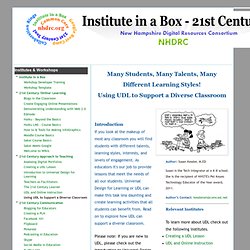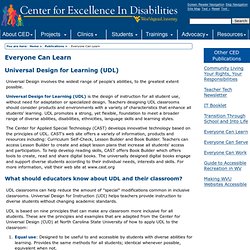

Virginia Commonwealth University Training and Technical Assistance Center Newsletter. Margaret Vaughan, M.Ed.

For the early childhood world, Universal Design for Learning suggests that instructional design encompass a range of flexible learning materials and activities. Consider for a moment a typical state-sponsored early childhood classroom for 4-year-old children. To qualify for the program, a child must be 4 by Sept. 30. Within the classroom, there may be a child whose birthday is Sept. 29, and one whose birthday is on Oct. 1.
Therefore, a student who is turning 4 at the end of September could have a classmate who is essentially a year older. Universal Design for Learning (UDL) is a blueprint or framework for supporting all learners of any age. Figure 1 For the early childhood world, UDL suggests that instructional design encompass a range of flexible learning materials and activities. Class climate. Many of these guidelines fall into the three principles of UDL, but may not be obvious areas of consideration when using the framework to inform teaching practices. Using UDL to Support a Diverse Classroom - nhinstitutes.
Introduction If you look at the makeup of most any classroom you will find students with different talents, learning styles, interests, and levels of engagement.

As educators it's our job to provide lessons that meet the needs of all our students. Universal Design for Learning or UDL can make this task less daunting and create learning activities that all students can benefit from. Read on to explore how UDL can support a diverse classroom. Please note: If you are new to UDL, please check out the Introduction to Universal Design for Learning Institute, UDL - What is it and How Does it Work? Getting Started Let's start by reviewing what Universal Design for Learning is. Click here to read about the UDL Curriculum on the National Center for UDL website. Click here to learn about UDL and Expert Learners. There are links to additional information that you can check out as well. You can learn about the UDL Guidelines and the three principles in this video from the National Center on UDL.
National Center On Universal Design for Learning. Universal Design for Learning (UDL) - Everyone Can Learn - Center for Excellence in Disabilities. Universal Design involves the widest range of people's abilities, to the greatest extent possible.

Universal Design for Learning (UDL) is the design of instruction for all student use, without need for adaptation or specialized design. Teachers designing UDL classrooms should consider products and environments with a variety of characteristics that enhance all students' learning. UDL promotes a strong, yet flexible, foundation to meet a broader range of diverse abilities, disabilities, ethnicities, language skills and learning styles.
The Center for Applied Special Technology (CAST) develops innovative technology based on the principles of UDL. CAST's web site offers a variety of information, products and resources including: Curriculum Self-Check, Lesson Builder and Book Builder. What should educators know about UDL and their classroom? UDL classrooms can help reduce the amount of "special" modifications common in inclusive classrooms. Table of Contents Individualized Education Plan (IEP) Universal Design for Learning: Meeting the Needs of All Students. Great Graphic: Maslow's Hierarchy of Needs. ALPHabiTunes. Free Digital Storytelling Tools For Teachers and Students. Learning Wheel.
Reading Comprehension & Language Arts Teaching Strategies for Kids.
UDL Lesson Builder: Explore Model UDL Lesson Plans.